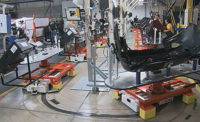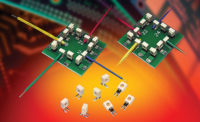Kilmainham Gaol is a unique museum in Dublin, Ireland, that is often bypassed by tourists seeking more popular sights. It's not what most people associate with the Emerald Isle. The austere building once housed political prisoners in tiny, dark, cold cells.
A nicer type of cell is a common sight in manufacturing plants throughout the United States. Cellular assembly offers numerous benefits, such as decreased throughput time and increased flexibility. However, installing an assembly cell and using it to achieve lean manufacturing goals are two different things. If workcells are not used correctly, they can confine assemblers to low productivity and fail to deliver the benefits of lean.
A workcell is a group of workstations, machines or equipment arranged so that parts can be assembled progressively from one station to another without having to wait for a batch to be completed or requiring additional handling between operations.
Cells may be dedicated to a process, a subcomponent or an entire product. They are conducive to single-piece manufacturing methods and are a key component of lean manufacturing initiatives.
"Cellular configurations can be in several forms, but equipment contained within the cell is normally configured in close proximity to compress time and space," says Richard Ligus, president of the Rockford Consulting Group (Rockford, IL). "Quick changeover from one product to the next is paramount for inducing cell velocity.
"A cell is configured normally for speed and minimal material handling, and can reap substantial benefits in cost saving, time compression and inventory reduction," adds Ligus. "Cells can have a substantial impact on a company's productivity and throughput. Flexible cells can be very effective when applied in an environment with a product characteristic of low volume and [high variety]."
Despite numerous advantages, workcells are one of the most misunderstood aspects of lean manufacturing. "There's still a tendency for people to think that lean equals cell," says Jamie Flinchbaugh, a partner in the Lean Learning Center (Novi, MI). "However, use of cells depends on what you're making. For instance, you wouldn't make a plane or a car in a cell, but lean manufacturing is widely used in the aerospace and automotive industries."
"One of the most common fallacies surrounding cellular manufacturing is that it is a cure-all for manufacturing ailments," adds Ligus. "I have seen [companies] use cellular concepts where they didn't belong, or had little practical application, just to put a spin on their ‘advanced approach' to production."
Beware of Fakes
Cellular manufacturing is not a new concept. It has been around since the days of Henry Ford. And, contrary to popular belief, workcells come in many different sizes and shapes. "Cells can be categorized into the good, the bad and the ugly," says Chet Marchwinski, communications director at the Lean Enterprise Institute (Brookline, MA).
"Companies achieve the full range of benefits from cellularization, including very short lead times, higher productivity, higher quality and increased output, by carefully designing cells to operate in continuous flow," says Marchwinski. "Companies fail to gain the full benefits of cells when they just rearrange equipment from traditional processing departments into U-shaped cells."
Marchwinski claims many assembly cells suffer from "fake flow," which is characterized by erratic and intermittent flow of product, fluctuating inventory accumulations between steps, output varying from hour to hour, and poor use of human effort. Fake flow occurs when manufacturers rearrange machines and workstations into what they think are cells. For instance, they install modules that are U-shaped and look like cells to the untrained eye.
"Almost any grouping of machines that performs processing steps in a sequence is labeled a ‘cell,'" says Mike Rother, a consultant affiliated with the Japan Technology Management Program at the University of Michigan (Ann Arbor, MI). "But, in most [so-called] cells, we see no continuous flow, which is really what makes a cell a cell.
"It only looks like a cell because of the shape," adds Rother. "However, shape does not make a cell. Flow makes a cell."
In fact, the word "cell" is often misused. "What we usually find is just a module, not a cell at all," Rother points out. "The individual assembly stations and operators are still functioning as isolated islands. The machines might as well be much further apart, because it doesn't make much difference."
Many people think modules are cells. "When you put modules together in a U shape, you get 25 percent to 30 percent improvement in flow," says Rick Harris, president of Harris Lean Systems Inc. (Murrels Inlet, SC). "But, going to a cell, you get 50 percent improvement."
When fake flow occurs, "there is only intermittent and erratic flow through the cell," adds Rother. "The cell's output gyrates from hour to hour and small piles of inventory accumulate between the processing steps. What we thought was a masterpiece is really a fake, returning little of continuous flow's potential benefits to the company."
Often, cellular solutions demand a level of capitalization that management may not be willing to commit. Some companies assign certain machines located in their original places across the factory from each other to a virtual cell and anoint it "cellular manufacturing."
"This is as practical as flying from New York to Cincinnati to Chicago to Denver to San Francisco and calling it a direct flight," says Ligus. "Other companies simply move equipment around in a closer proximity and call it a ‘cell,' which is the same as moving furniture around a room. We call this ‘shuffling the deck chairs on the Titanic.' If the man-to-machine ratio remains the same, then all you have accomplished is closing the distance for material handling."
Cell Design Woes
Contrary to popular belief, workcells come in a wide variety of shapes and sizes. Many people think a cell has to be U-shaped. While that is the most popular shape, cells can also be made in other configurations. For instance, Harris says X- and T-shaped cells are commonly used, in addition to cloverleaf-shaped cells. However, approximately 75 percent of all assembly cells are U-shaped.
"Shape depends on the size and complexity of the assembly," explains Harris. He says the width of the cell is more important than the shape. "A classic mistake is making the cell too big," Harris points out. "No cell should be wider than 5 feet-just enough room for two individuals to pass through. I've seen some cells as wide as 20 feet."
While a plant can have many different cell designs, each cell should be tailored to specific needs. According to Ligus, the shape of the cell should be determined by the equipment and processes to be employed, the part flow through the plant-where the parts are coming from and where they need to go-and physical restraints, such as columns. "What's important is that workstations are configured for close proximity and part velocity," says Ligus.
"The best way to approach cellular assembly is to use a scalar configuration," claims Ligus. "[That way] production volume increases or changes in product mix can be addressed using a building block approach."
Ligus says one of the worst ways to configure an assembly cell is to "spread it out across the plant floor, making it physically cumbersome to get the components that are needed, or not to locate it in close proximity to its feeder cells."
According to Flinchbaugh, engineers should start with a concept and build the cell out of wood and cardboard. "From that, you can learn all kinds of things, such as how material and people will really move," he explains. "That input should be received before equipment is even specced, not after it's already [in place]."
When manufacturing engineers design assembly cells, Rother says they often make three critical mistakes:
1. They rely too much on standard times instead of going to the shop floor with a stop watch and working to analyze and understand the work elements there. "Traditional time-study methods are not effective," warns Rother. "They're designed for making a quick analysis and they tend to focus on only one workstation, rather than maximizing the entire flow. Some people incorrectly believe this only takes 15 minutes. But, Toyota can take 2 weeks to establish a cell."
2. They tend to place a person at each assembly station. "If the work content at each station doesn't match the customer takt time, then they have permanently baked waste into the process," says Rother.
3. They tend to incorrectly design and utilize automation. "As a result, operators become tied to the machines," notes Rother.
"These problems can be fixed," claims Rother. "Managers and engineers need to focus in on the details within each cell to root out the poor flow and excess numbers of operators, who can be redeployed." Unfortunately, Rother says many engineers "leave too much up to the vendor or assign the line design task to new engineers without much experience."
Many engineers also fail to look at the fine details of operator activity in the cell. "They fail to tell the operator what they're trying to accomplish," says Flinchbaugh. In addition, some engineers are guilty of failing to observe the problems operators encounter. "A lot of people turn the key and walk away," notes Flinchbaugh. "They fail to educate people on why they're doing things a certain way."
Material Mishandling
Many plants are creating lean processes, but struggling to keep them supplied with parts because they are using material handling systems developed for traditional mass production operations. "In addition, material handling problems plague many cells because the flow of purchased parts to them is erratic," says Marchwinski.
Unfortunately, the delivery of raw materials and pick-up of finished goods from cells occurs as an afterthought in many plants. As a result, the benefits of cells aren't fully realized.
"If you put a cell in without really thinking about material flow, you can end up with a product that travels through three cells instead of only one," warns Flinchbaugh.
He also says many assembly cells cannot be easily and quickly reconfigured to address flexible manufacturing requirements. "We need equipment that can be raised up onto wheels and pushed around, or at least with hand-cart holes to be lifted and moved, which means they can't be lagged down," explains Flinchbaugh. "We also need quick-disconnect for electricity, water, steam, compressed air or anything else we might hook up so we can ‘unplug' it as easily as a laptop."
Ideally, Flinchbaugh says "you should have a matrix of pipes and conduits running above your shop floor that you can quickly tap into anywhere. All hook-ups should be as standard and easy to use as the USB board in a personal computer."
In addition, little engineering effort should be required to move equipment. "You shouldn't need an electrician, a pipe fitter, a plumber and a millwright every time you want to move something," notes Flinchbaugh.
Ideally, cells should be flexible enough to be moved by operators in less than 30 minutes. "Quick changeover is paramount in a cellular environment to achieve velocity," says Ligus. "Velocity, in turn, shortens lead times and allows a company to achieve a ‘receive order today, make and ship tomorrow' strategy. This kind of speed in manufacturing is no longer [something that is] ‘nice to have.' It is a recipe for survival in today's global economy.
"Cellular manufacturing is no panacea, nor should it be embraced as a religion," concludes Ligus. "It is an operational strategy that, if implemented correctly, will provide a new dimension to competing."


